MATTERS OF OBSESSION
The figurative ‘ghost’ that haunts the art at August House
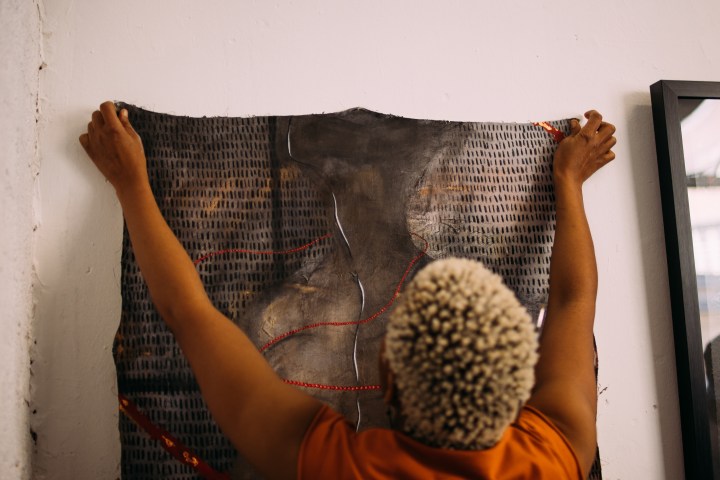
The pressure to survive and make money shape what kind of art is created at this famous Joburg artist space.
He has long since left the building, moving on to establish an independent artists’ space, however, in some ways, the presence of Nelson Makamo is still felt at August House.
If one clicks on the 44 artist names linked to the website of this well-known building in Doornfontein that houses artist’s studios, from their portfolios emerges quite a bit of figurative portraiture. It is often rendered in the style now synonymous with the world-famous artist — sometimes down to the charcoal scrawls and spherical spectacles.
But it stands to reason that many of them — still rising as professionals — are looking to mimic the trail blazed by one of the atelier’s most successful alumni.
“There is a reason why artists get trapped in portraiture,” says Sara Hallatt, a founder of the Meta Foundation, which creates programming for August House.
“[It’s] because people that can’t afford a Nelson want something similar to Nelson. And because people buy that work, people keep making that work. It is different for different artists but you hope, at some point, through their practice, through experimentation and play, they start slowly moving away from that, ironically, they will be much more successful in their uniqueness than in copying. But it’s hard to make that leap, either financially or from a self-confidence point of view.”
In a sense, Hallatt’s role, which she took on in early 2020, is to facilitate an environment which enables the building of confidence and this unfettered play, while keeping an eye on attracting the right profile of artist. “The presumption there is that they are [far] enough into their careers that they are selling work, which then allows them to take a space.”
But it is easier said than done. Hosting over 40 artists, August House is possibly the largest artist space in the country. “Most sensible people stop at 15 or 20,” says Hallatt. Due to an uncertain pandemic-impacted environment, the fortunes of many artists remain unpredictable, creating a high-turnover environment.
However, even in the earlier days (between 2006 and 2014), when Bié Venter (who then was co-50% owner with Maria Svane) was responsible for bringing artists into August House and acting as a liaison with the owners and the management team, keeping the space thriving as an atelier presented many challenges.

Artist Mbongeni Fakudze talking to visitors at OpenStudios.Joburg. Image: Marc Hervé

Visitors exploring End Street Studios, at August House during OpenStudios.Joburg. Image: Marc Hervé
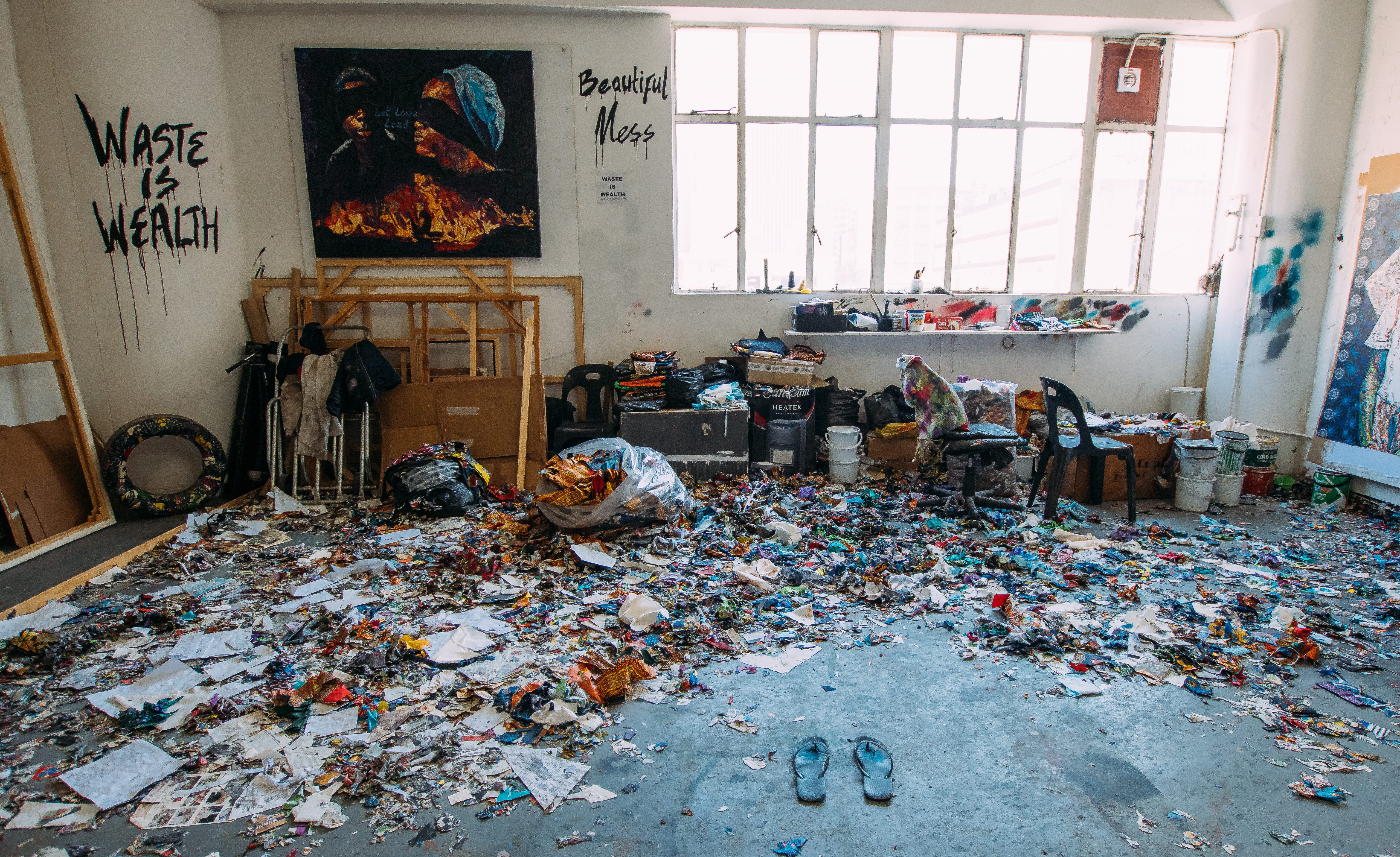
A view into the studio of artist Sanusi Olatunji. Image: Marc Hervé.
In her book titled August House is Dead, Long Live August House writer and artist Kim Gurney writes: “Her [Venter’s] role included taking risks on tenants who didn’t have references as they were young and emerging talents. The other owners were open to this, but it took a lot of work: ‘I had to convince the shareholders that there is value in art. They didn’t understand what the value of art is … They do understand now.’ They came to love certain tenants but it was difficult when people didn’t pay rent. Some had debt backlogs stretching back years. Although the building as an atelier never made any money, Venter says, the owners felt it was better than having it stand empty as some inner city buildings did”.
“When the building was in the process of being sold (around 2014/2015), there was a huge flight of artists,” says Hallatt. “People were convinced it was going to be turned into something else from what it was. And they had had such a lovely time here that they didn’t want to lose that feeling. When it was taken over [by Dave Mayers], it was almost like starting again. The place was radically chopped up and changed. He put up more studio space.”
One of the artists who moved out prior to this change in management says her tenure as an artist living there had been characterised by a level of casualness and privacy. “Management was not involved much except in practical maintenance of the building. Rent was affordable and the spaces were large,” she says. The building is currently managed by Quorum Holdings, a company in which Dave Mayers is the CEO.
Former resident, Themba Khumalo, who worked from August House between 2015 to 2022, having initially done an apprenticeship at Artist Proof Studios, says that for many of the years he worked there, artists had started to feel that “respect for artists was not commonplace” and that most artists had “relied on their own clients” to survive, without much assistance from the building’s management to promote the destination.
“I saw a lot of guys get locked out of their studios by the third of the month for failing to pay rent,” says Khumalo. “Then it moved to where you could pay using your artwork, an artwork of their choice.”
When approached for comment, David Mayers, the CEO of Quorum Holdings, said “We strongly deny Themba’s accusation. We work with every single artist to help ensure their sustainability. This support can come in the form of actively promoting their work, to help them generate cash flow, finding opportunities for them to participate in the market, helping them to carry the debt for a period of time or providing payment plans. When none of these make an impact on the artist’s livelihood, we will re-assess their ability to remain in the space. We very much treat each artist as an individual and review their situation on a case-by-case basis. August House is always walking a line between trying to balance any debt, support the artists and keeping the building operating.”
Khumalo says a lot of artists who were seduced by the prospect of working from an atelier found the reality of the promise to be sobering. “When you’re just fresh out of university, it was easy to think that you’d have clients and just sell,” he adds.
“August House came with that perception at some point. But a lot of clients came there looking for specific artists. They’d take time to buy your work if they don’t know you, because they need to study you… On this side, you have to pay rent. It led to a lot of impatience.”
Paying rent for a studio made him work harder because he had to sell, whereas before, he didn’t have that type of pressure, he adds. “I did a lot of cityscapes [mostly in charcoal], because they were easy to sell, but then I would experiment at the same time. I tried to create a balance.”
Khumalo, whose signature motifs are parched landscapes dotted with figures and sparse urban infrastructure rendered largely in charcoal, says he pondered his departure from the August House for several years, anxious about losing clients if he moved to a new space because “August House had become well-known, even though it was in a dodgy place.”
Although he was already on his way out, Khumalo says Meta Foundation made its presence felt in the sense that, “There is more effort now. I’ve seen a lot more curatorship. But I don’t know in terms of buyers. I think there is still a struggle for buyers. I think there are more fans than buyers; people who like the work more than wanting to buy it.”
Kamogelo Masemola (an artist from the East Rand who spent about four years in August House from 2015 and often crossed paths with Khumalo), says the likes of Khumalo — who formed part of a contingent of artists who had done printmaking programmes at Artist Proof Studios — were often cushioned by an existing network of buyers cultivated since their time there. A masterful drawer, painter and colourist, Masemola says he struggled to hold on to his artistic vision during a period in which buyers’ tastes leaned quite heavily towards the Makamo aesthetic.
Phenomenally talented and able to experiment at will, Masemola says his disillusionment with the fickle tastes of the art market led to a loss of focus during this period and a certain level of demoralisation.
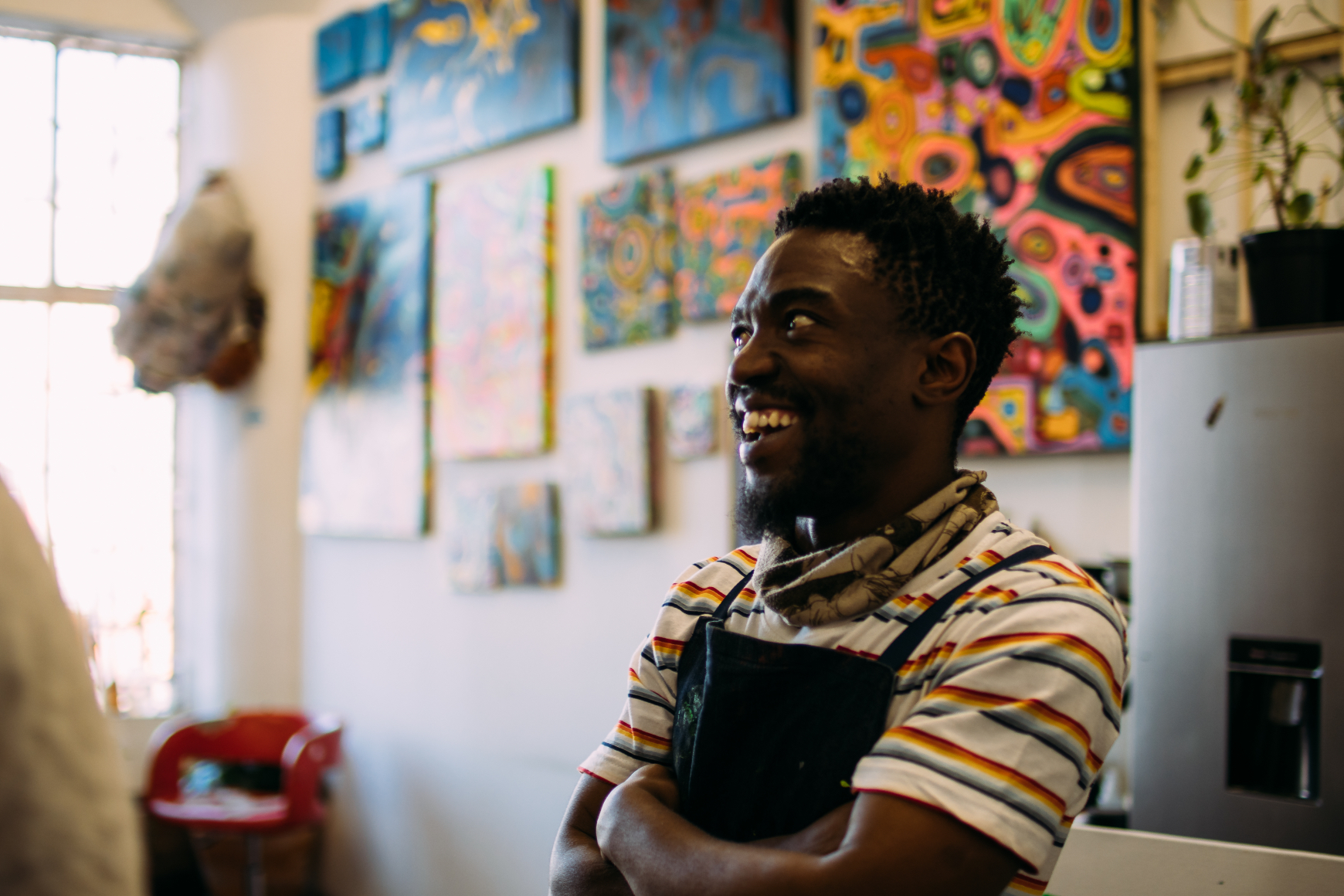
Artist Khotso Motsoeneng in his studio at August House. Image: Marc Hervé
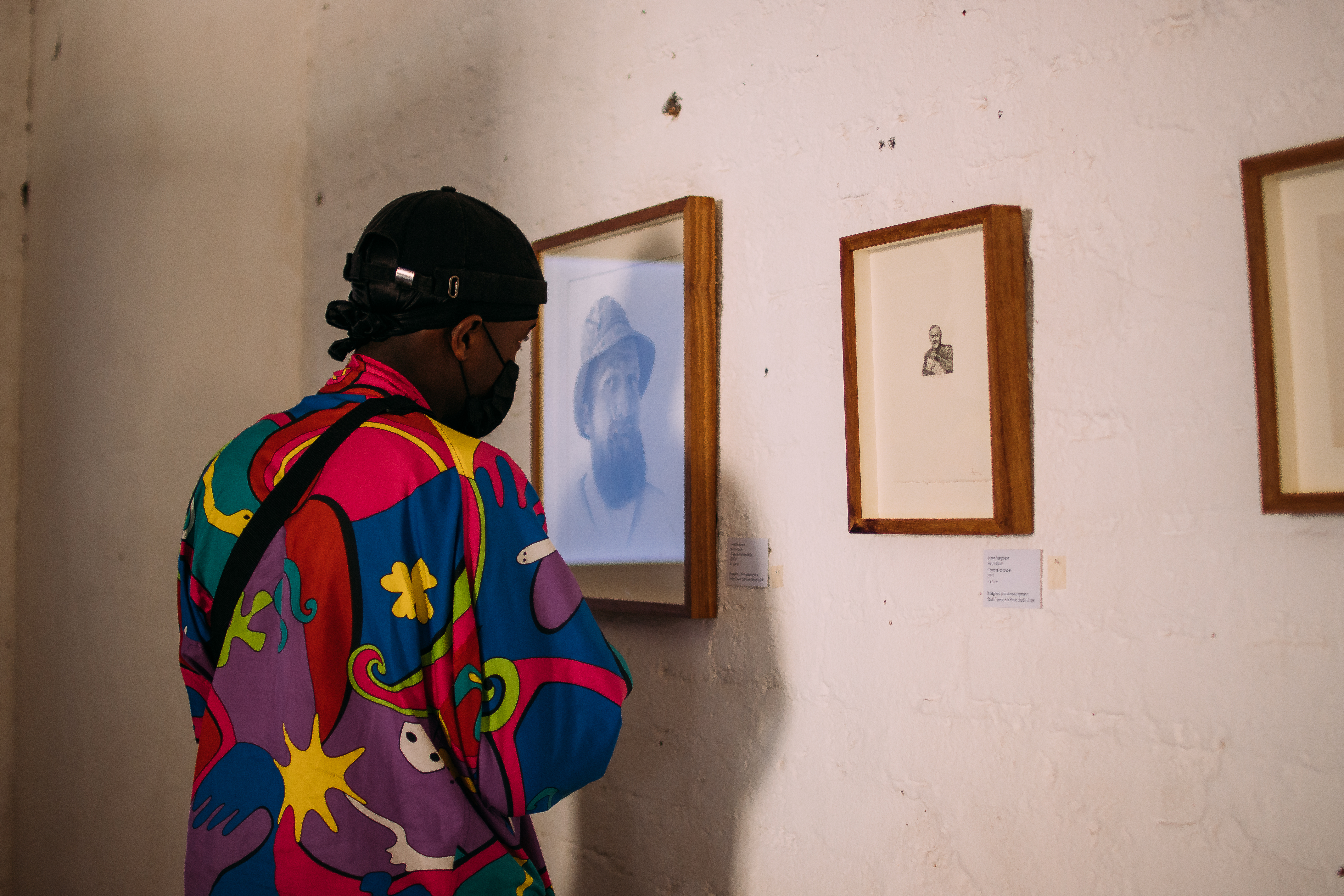
A visitor looking at Johan Stegmann’s artwork, as part of a group exhibition entitled “Broken Telephone”, curated by Olwethu de Vos. Image: Marc Hervé
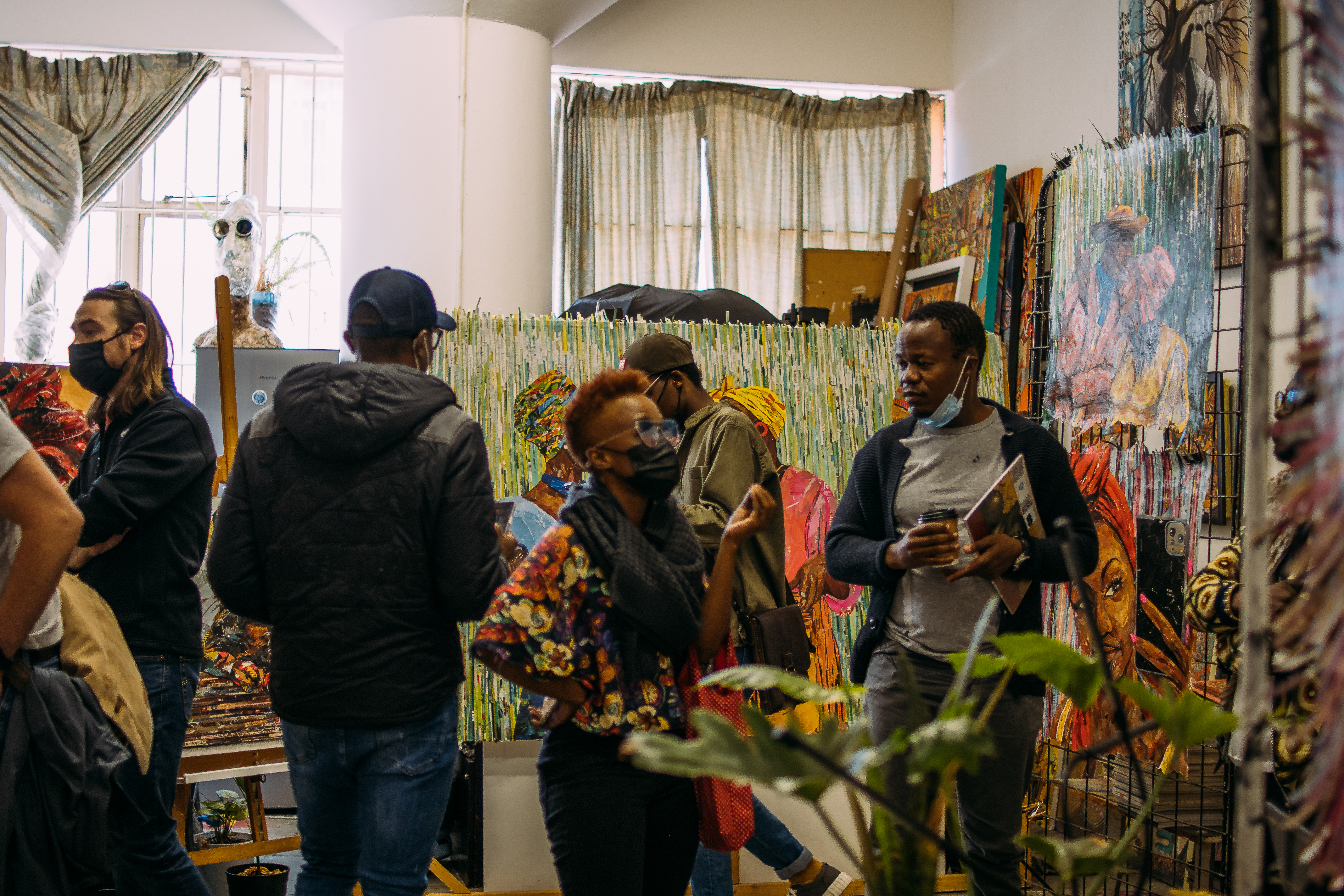
Visitors in the studio of Artist Jibril Linjoum Achu at August House during OpenStudios.Joburg. Image: Marc Hervé

Leigh Le Roux in his studio at August House. Image: Marc Hervé
A relatively new entrant into the August House saga, Hallatt’s tenure coincided with lockdown restrictions, meaning her priorities were a mixture of her hardcore mandate as the founder of the Meta Foundation and “the softer stuff”, like providing mental and emotional support to artists whose means of survival was suddenly cut off. “By October 2020 we had an Open Studios for August House artists,” she says. “I don’t control what the other studio spaces (Ellis House, Transnet Building) do, but as a group, we decided that we needed to do something to try and bring the money in.” Hence, a year later, the Open Studios idea was expanded and co-ordinated to include Bag Factory, Ellis House, Living Artists Emporium, Victoria Yards and Nugget Square, becoming a model for Open Studios Johannesburg, which included a tour of eight studios over two days in late May 2022.
“When I was at Bag Factory (from 2011 to 2017), if you did an Open Studios you’d be lucky if you got 30 people to come,” she says. “We had 1,200 people here in May. The artists have to come to the party. The artists have to take responsibility for participation in the events that are organised”.
When asked whether the successive Open Studios have had a tangible impact on sales for August House artists, Hallatt says she had yet to measure sales before May 2022 and will only have a better understanding of figures after May 2023 — sales can often take months to finally materialise. “But I think buyers enjoy the engagement with the artists,” she says. “My anecdotal feedback is that that [Open Studios model] builds longer-term relationships with artists. Whether they buy immediately or come back later, often they come back with a higher level of frequency to the artists.”
Hallatt has faith in August House as it stands presently as something of an incubator. “One hopes to find people in young format and help them through their careers over time, in the hopes that out of ten, maybe one will be around in ten years’ time.”
She is working to diversify the space, which remains overwhelmingly male, by developing an array of attractive programmes that include residencies, studio exchanges, workshops, exhibitions, an ongoing Latitudes page and tons of social media marketing. “As far as being a commercial space that churns out portraiture, we’re working hard to present different kinds of works from different voices,” Hallatt says. “There are still very few voices from the LBGTQI space and very few women here — less than 10% of the studios’ population. We still need a host of programmes to institute in order to do that.” DM/ ML
Sosibo is participating in a Writer’s Residency at August House facilitated by the African Art Content Agency, a non-commercial art journalism project.
Open Studios takes place on Sunday 30 October from 10:30am until 4pm. Tickets are R30 online or R50 at the door. The programme includes meeting 40 artists, a screen printing demonstration, a kids’ area and food and drinks will be on sale. A shuttle service ferries guests from Access City. Tickets can be purchased through Quicket. Visit here for more information.
This story has been edited with further comments from David Mayers, the CEO of Quorum Holdings on Friday 21 October.
In case you missed it, also read Navigating a network of artist studios in the centre of Joburg
Navigating a network of artist studios in the centre of Joburg
Visit Daily Maverick’s home page for more news, analysis and investigations





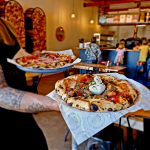












 Become an Insider
Become an Insider
Artists need to balance /juggle their work, creative growth, productivity and exhibiting and sales and wear several hats, often all at the same time. Reliance on a venue like having your own studio gallery or like the building in the article can be too restricting. Better to venture into all sorts of exhibiting/ sales spaces. You have to go meet your public and find where they are as well as invite them to where you are. The great thing is to believe your people are out there and will respond if given a chance.
For better or worse, art has become a commodity, and the art world is a hard one, with certain in-built realities, the most important of these being that your work is accessible and sells. Having an atelier is no guarantee. Not even talent will guarantee sales. And artists are not the best individuals to still their work, anyway. That’s a job in itself.
It’s cold out there, being outside of the gallery system, and chances are you will not reach full potential ito exposure to audience/buyers and currency. You might start at a studio space, hoping that a collector spots you, or end at one, when you are established enough to dictate your own route, but for the most, dealers and galleries provide the confidence that buyers also seek when they’re dropping R50k on a work.